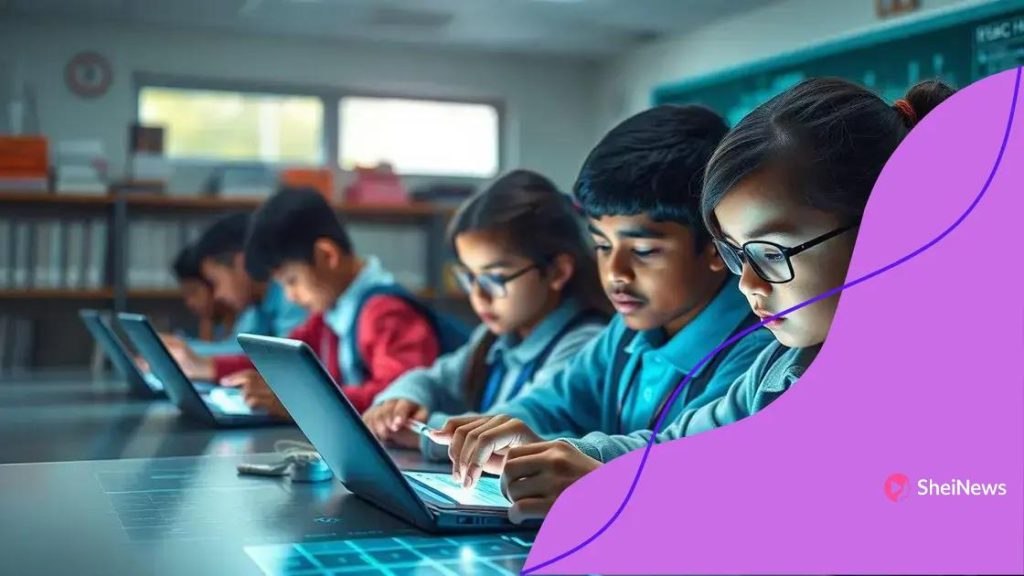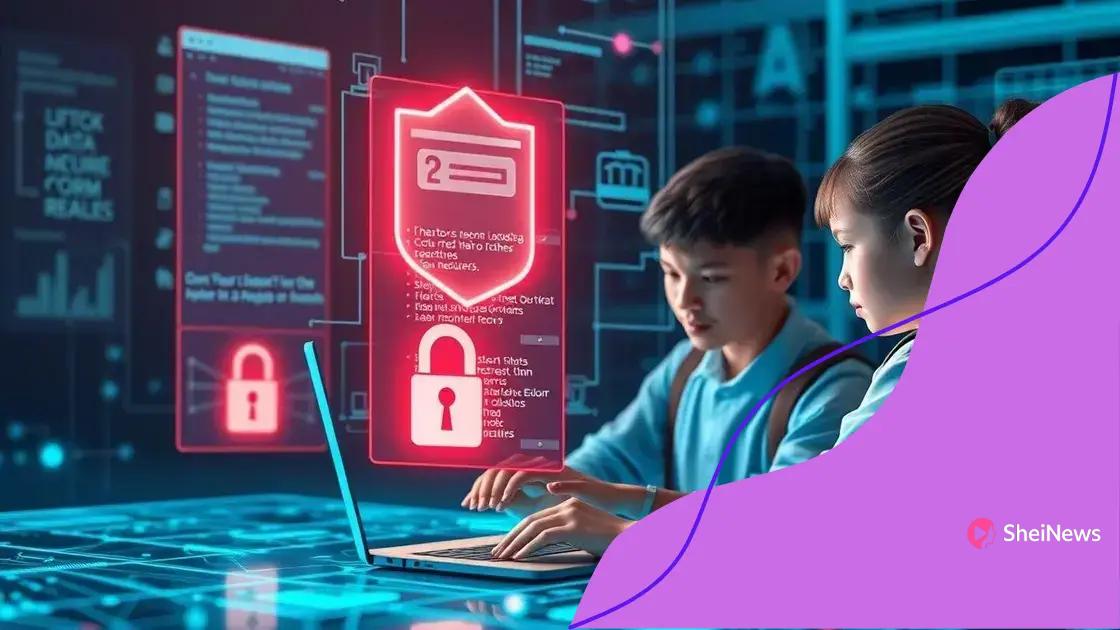Blockchain for secure student records

Anúncios
Blockchain for secure student records ensures data integrity, enhances accessibility, and protects sensitive information, making credential verification quicker and more efficient for educational institutions and employers.
Blockchain for secure student records represents a game-changer in the way educational institutions maintain trust and security. Imagine a future where student’s academic achievements are safely stored, and verification becomes a seamless process. Are you curious about how blockchain could reshape education?
Anúncios
Understanding blockchain technology
Understanding blockchain technology is essential to grasp how it can change the way we manage student records. This innovative technology offers a method to securely store and share information between parties. By using a decentralized system, blockchain ensures that data remains tamper-proof and transparent.
How Does Blockchain Work?
At its core, blockchain consists of a series of blocks that store data. Each block is linked to the previous one, forming a chain. This structure makes it difficult to alter any single block without affecting the entire chain, thus providing security.
Key Features of Blockchain:
- Decentralization: Unlike traditional databases, blockchain operates on a network of computers, reducing the risk of data loss.
- Transparency: All transactions are visible to participants, ensuring accountability.
- Security: Data is encrypted, making unauthorized access extremely difficult.
As educational institutions begin to adopt this technology, it’s crucial to understand how it not only protects sensitive student data but also fosters trust among stakeholders. By using blockchain, schools can verify academic achievements without relying on centralized authorities. Students can control who accesses their records, leading to greater privacy and security.
Anúncios
Moreover, the ability to quickly verify credentials can streamline the admissions process for colleges and employers alike. Imagine a world where diplomas and transcripts are easily shared and verified through a secure online platform. This potential is what makes blockchain for secure student records such an exciting development in education.
The Future of Blockchain in Education
Looking ahead, the implications of blockchain technology in education are vast. Schools and universities can create a more efficient system that reduces administrative burdens. As institutions begin to explore these opportunities, it is clear that understanding blockchain technology is the first step toward innovation.
Benefits of blockchain for education
The benefits of blockchain for education are numerous and impactful. By incorporating this technology, educational institutions can enhance the integrity and efficiency of their systems. One major advantage is the ability to streamline the verification process for student credentials, which can reduce waiting times for both students and employers.
Improved Data Security
Blockchain technology offers exceptional security features. Information stored on a blockchain cannot be easily altered, which helps prevent fraud. This is particularly important for protecting student records and ensuring that qualifications are genuine.
Increased Transparency
Another key benefit is transparency. All transactions recorded on the blockchain are visible to authorized users. This level of openness fosters trust among students, educational institutions, and employers.
- Enhanced trust: Students can confidently share their credentials, knowing that they cannot be tampered with.
- Reduced administrative workload: Institutions can automate data sharing and verification.
- Lower costs: By cutting down on paperwork and administrative tasks, schools can save resources.
Additionally, blockchain can help maintain a permanent and unalterable record of a student’s achievements. This means that students will have their credentials and accomplishments verified without the hassle of contacting multiple parties. As education evolves, the integration of blockchain can create a more efficient and reliable system.
Furthermore, students can have more control over their data, choosing who to share it with and when. This empowerment is crucial in today’s digital landscape, where privacy concerns are a significant issue.
The Future Impact of Blockchain on Education
The potential impact of blockchain on education is vast. As institutions continue to explore these benefits, we might see a significant shift in how student records are managed. Overall, the benefits of blockchain for education not only enhance security and transparency but also create a more streamlined experience for all involved.
How blockchain can secure student data

Understanding how blockchain can secure student data is crucial as educational institutions seek to protect sensitive information. Blockchain technology provides a secure method of storing, sharing, and validating student records. By utilizing decentralized networks, the risks of unauthorized access and data breaches are significantly reduced.
Encryption and Security
One of the primary ways blockchain secures data is through encryption. Each piece of information on the blockchain is encrypted, ensuring that only authorized users have access. This level of protection keeps student records safe from cyber threats.
Immutable Records
Additionally, blockchain creates immutable records. Once information is recorded, it cannot be altered or deleted. This guarantees the integrity of student data, providing a sense of trust for both students and educational institutions.
- Decentralization: By distributing data across multiple nodes, there is no single point of failure.
- Access Control: Students can decide who accesses their records, enhancing privacy.
- Real-time Updates: Changes to records can be made instantly, ensuring the data stays current.
When students apply for jobs or further education, they need a reliable way to share their academic history. Blockchain allows for quick verification, which benefits both students and employers. Moreover, this technology eliminates the need for lengthy verification processes, allowing for smooth transitions from one educational institution to another.
In the future, as more schools adopt blockchain, the security of student data will improve alongside advancements in technology. This ensures that the sensitive information is handled with the utmost care, creating a safer educational environment.
Challenges in implementing blockchain for records
While there are many advantages to using blockchain in education, there are also several challenges in implementing blockchain for records. Understanding these challenges is essential for institutions considering this technology.
Cost of Implementation
One of the first obstacles is the cost associated with implementing blockchain technology. Establishing a blockchain infrastructure requires significant investment in both technology and training. Schools may find it challenging to allocate funds for these necessary changes.
Technical Expertise
Another hurdle is the need for technical expertise. Many educational institutions lack professionals with the skills to develop and manage blockchain systems. This gap can slow down the adoption of the technology.
- Limited knowledge: Staff may require extensive training to understand blockchain basics.
- Need for collaboration: Institutions must work with tech companies to effectively utilize blockchain.
- Maintenance challenges: Ongoing support and updates are necessary to keep the system running smoothly.
Additionally, as blockchain is still an emerging technology, some organizations are hesitant to adopt it due to uncertainty regarding its long-term viability. This skepticism can hinder progress, as decision-makers may wait for proven results before embracing the change.
Despite these challenges, the potential rewards of blockchain in education are significant. Institutions must carefully weigh the risks and benefits when considering this technology. As more schools explore blockchain, sharing knowledge and experiences will help mitigate difficulties and pave the way for smoother implementation.
Future of student records in the blockchain era
The future of student records in the blockchain era promises exciting changes for education. As technology continues to evolve, blockchain could redefine how academic credentials are stored and shared. With its decentralized nature, it offers a secure way to manage records.
Enhanced Accessibility
One major benefit of blockchain is enhanced accessibility to academic records. Students may access their credentials anytime using a secure digital wallet. This ease of access could simplify interactions with potential employers and educational institutions.
Streamlined Processes
Moreover, the future may also see more automated processes. Verification of degrees and transcripts could happen almost instantly, freeing students and institutions from lengthy waiting periods. This efficiency not only benefits students but also employers who need quick confirmation of qualifications.
- Secure sharing: Students can share their records directly with employers without third-party involvement.
- Privacy control: Students can choose who sees their information, allowing them to retain their privacy.
- Global standardization: Blockchain could help create a uniform system of record-keeping across different institutions worldwide.
As more schools adopt blockchain, we can expect greater collaboration across the education sector. Schools, employers, and students may work together in ways that enhance trust and transparency. By using this technology, educational institutions can create an environment where credentials are easily verifiable and immutable, building confidence among all stakeholders.
The transition to a blockchain-based system may not be immediate, but the vision is clear. The integration of technology will help to transform student experiences in education and beyond, creating a smarter and more secure future.
FAQ – Frequently Asked Questions about Blockchain for Student Records
What is blockchain technology?
Blockchain technology is a decentralized system that securely records information across multiple computers. It ensures data integrity and transparency.
How does blockchain enhance security for student records?
Blockchain encrypts student data and creates immutable records, making it nearly impossible to alter or hack, thus ensuring a high level of security.
What are the benefits of using blockchain in education?
Using blockchain improves data accessibility, allows for quick credential verification, enhances privacy for students, and encourages a standardized record system.
What challenges do schools face when implementing blockchain?
Schools may face challenges such as high implementation costs, the need for technical expertise, and skepticism about the effectiveness of the technology.





